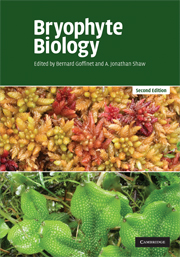Book contents
- Frontmatter
- Contents
- List of contributors
- Preface
- 1 Morphology and classification of the Marchantiophyta
- 2 Morphology, anatomy, and classification of the Bryophyta
- 3 New insights into morphology, anatomy, and systematics of hornworts
- 4 Phylogenomics and early land plant evolution
- 5 Mosses as model organisms for developmental, cellular, and molecular biology
- 6 Physiological ecology
- 7 Biochemical and molecular mechanisms of desiccation tolerance in bryophytes
- 8 Mineral nutrition and substratum ecology
- 9 The structure and function of bryophyte-dominated peatlands
- 10 Population and community ecology of bryophytes
- 11 Bryophyte species and speciation
- 12 Conservation biology of bryophytes
- Index
- References
4 - Phylogenomics and early land plant evolution
Published online by Cambridge University Press: 06 July 2010
- Frontmatter
- Contents
- List of contributors
- Preface
- 1 Morphology and classification of the Marchantiophyta
- 2 Morphology, anatomy, and classification of the Bryophyta
- 3 New insights into morphology, anatomy, and systematics of hornworts
- 4 Phylogenomics and early land plant evolution
- 5 Mosses as model organisms for developmental, cellular, and molecular biology
- 6 Physiological ecology
- 7 Biochemical and molecular mechanisms of desiccation tolerance in bryophytes
- 8 Mineral nutrition and substratum ecology
- 9 The structure and function of bryophyte-dominated peatlands
- 10 Population and community ecology of bryophytes
- 11 Bryophyte species and speciation
- 12 Conservation biology of bryophytes
- Index
- References
Summary
Introduction
This is the era of whole-genome sequencing; molecular data are becoming available at a rate unanticipated even a few years ago. Sequencing projects in a number of countries have produced a growing number of fully sequenced organellar and nuclear genomes, providing computational biologists with tremendous opportunities, but also major challenges. The sheer amount of data is nearly overwhelming; comparative frameworks are needed. Comparative genomics was initially restricted to pairwise comparisons of genomes based on sequence similarity matching. The importance of taking a multispecies phylogenetic approach to systematically relating larger sets of genomes has only recently been realized.
Something can be learned about the function of genes by examining them in one organism, or by comparisons between two organisms. However, a much richer approach is to compare many organisms at once by using a phylogenetic approach, which lets us take advantage of the burgeoning number of phylogenetic comparative methods. A synthesis of phylogenetic systematics and molecular biology/genomics – two fields once estranged – is beginning to form a new field that could be called “phylogenomics” (Eisen 1998). We need to take advantage of the rich, multispecies approach provided by taking into account the history of life. Repeated, close sister-group comparisons between lineages differing in a critical phenotype (e.g. desiccation- or freezing-tolerance) can allow a quick narrowing of the search for genetic causes in a sort of natural experiment.
- Type
- Chapter
- Information
- Bryophyte Biology , pp. 173 - 198Publisher: Cambridge University PressPrint publication year: 2008
References
- 2
- Cited by

